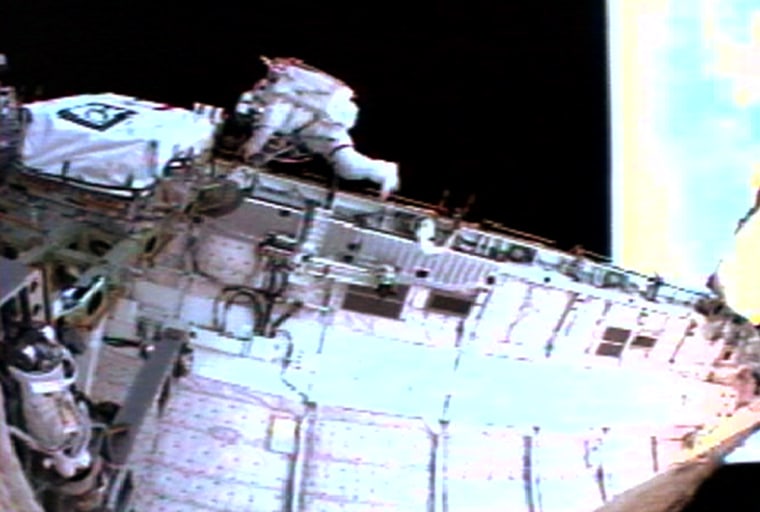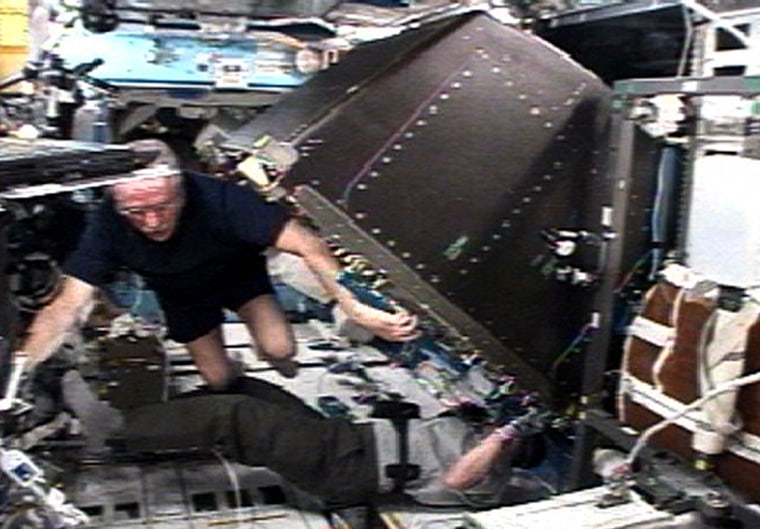Astronauts on Sunday loaded up supplies and hauled out mounds of trash that have accumulated on the international space station since shuttles were grounded after the 2003 Columbia tragedy.
“It is kind of just like working in your closets and your garage,” station flight director Mark Ferring said. “It’s a lot of work.”
Discovery, which docked at the orbiting outpost Thursday, became the first shuttle to return to orbit last week. Among the mission’s goals: Resupply the station and take out the trash.
The astronauts are unloading 15 tons of cargo and expect to return to Earth with 13 tons of trash and other items that are no longer needed on the station.
Mission extended
When the station’s two-man crew awoke Sunday, they were told that their seven Discovery guests would remain at the station for an additional day.
“Hopefully it is not going to be like the relatives who miss their flight and have to stay another day,” Charles Hobaugh, who works in the station’s mission control, told crew members by radio.
A ninth day at the station was approved late Saturday, days after NASA decided to ground future shuttle missions because an almost one-pound piece of foam broke free of Discovery’s external fuel tank. The piece of foam missed Discovery, but was a haunting reminder of the 1.67 pound chunk that doomed Columbia and its seven astronauts.
“We were surprised. Not that little pieces of foam were coming off the tank, but that such a large piece could come off,” astronaut Charles Camarda told NBC’s “Meet The Press” from aboard Discovery Sunday.
NASA spent hundreds of millions of dollars over 2½ years redesigning the external tank after Columbia disintegrated over Texas, but said last week it did not solve the problem and more work is needed.
'That's the correct course of action'
Once the astronauts aboard Discovery learned a large piece of foam peeled from the tank as they rocketed to space, Astronaut Andrew Thomas said the decision to stop flying was obvious.
“We were of a single mind up here, I think, that it was necessary to stop flying in order to repair this problem,” he told Fox News. “That’s the correct course of action.”

Discovery Commander Eileen Collins said she’s confident the shuttle will get her crew home safely and looks forward to reminding her children to brush their teeth.
“I miss them a lot,” she told ABC’s “Good Morning America.” “I’m looking forward to getting back into the mother routine again.”
But while at work, Collins said her main goals for the mission were to return the shuttle to space and resupply the station.
Key supply mission
Discovery will leave the orbiting lab in much better shape than when the shuttle arrived, said Bill Gerstenmaier, the station’s program manager. Water will be left behind, as well as laptops, wash cloths, a printer, dry wipes, floppy disks, food and nitrogen.
“We are going to be in very good shape through the end of the year,” Gerstenmaier said.
Shuttles are needed for the supplying and continued construction of the station.
When NASA’s shuttles were grounded in 2003, the agency began relying on Russian vehicles to deliver supplies to the station. However, the Russian cargo ship Progress cannot haul the weighty items the shuttle can. The next delivery by Progress is scheduled for September.
Gerstenmaier said station managers prepared for a scenario in which there would be no shuttle flights this year. Despite that, he said the grounding of future shuttle missions opens the station to risk.
“We are still susceptible to some large failure of some component that can only be delivered by the shuttle,” he said.
Among the tasks Discovery’s astronauts performed for the station was the reconfiguring of a gyroscope, which failed in March. Four gyroscopes, each weighing 660 pounds, are intended to steer the station, but only two have been working in recent months.
Space station maintenance
On Monday, during their second spacewalk, Discovery astronauts Stephen Robinson and Soichi Noguchi planned to replace the other failed gyroscope, which has not worked since 2002.
The pair planned to go over procedures for installing the gyroscope on Sunday with Thomas, who was set to direct Monday’s replacement from inside the shuttle.
As they began spacewalk preparations Sunday, Robinson informed Mission Control’s Stephen Frick that things might proceed slower than anticipated.
“If you saw what our mid-deck looks like right now, you’d see why,” Robinson said as his colleagues transferred items between the shuttle and station. “It’s a high traffic zone.”
